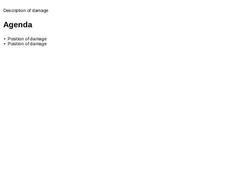
|

|
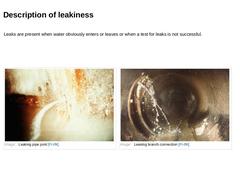
|

|
Leaks are present when water obviously enters or leaves or when a test for leaks is not successful. |
(Image: Leaking pipe joint [FI-IfK])
|
(Image: Leaking branch connection [FI-IfK])
|
|
|
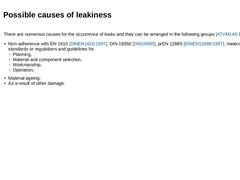
|

|
There are numerous causes for the occurrence of leaks and they can be arranged in the following groups [ATVM143-1:1989] : - Non-adherence with EN 1610 [DINEN1610:1997], DIN 19550 [DIN19550], prEN 12889 [DINEN12889:1997], material standards or regulations and guidelines for
- Planning,
- Material and component selection,
- Workmanship,
- Operation;
- Material ageing;
- As a result of other damage.
|
|
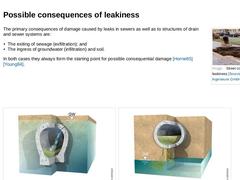
|

(Image: Street collapse caused by leakiness) The primary consequences of damage caused by leaks in sewers as well as to structures of drain and sewer systems are: - The exiting of sewage (exfiltration); and
- The ingress of groundwater (infiltration) and soil.
In both cases they always form the starting point for possible consequential damage [Horne85] [Young84]. |
(Image: Infiltration)
|
(Image: Exfiltration)
|
|

|

|
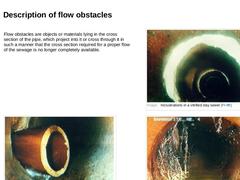
|

|
Flow obstacles are objects or materials lying in the cross section of the pipe, which project into it or cross through it in such a manner that the cross section required for a proper flow of the sewage is no longer completely available. | (Image: Incrustrations in a vitrified clay sewer [FI-IfK])
| | (Image: Buidling connection projecting into a sewer [FI-KMG])
| (Image: Root ingress in the region of a pipe joint [FI-KMG])
|
|
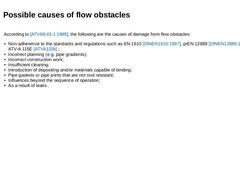
|

|
According to [ATVM143-1:1989], the following are the causes of damage from flow obstacles: - Non-adherence to the standards and regulations such as EN 1610 [DINEN1610:1997], prEN 12889 [DINEN12889:1997], ATV-A 115E [ATVA115b] ;
- Incorrect planning (e.g. pipe gradients);
- Incorrect construction work;
- Insufficient cleaning;
- Introduction of depositing and/or materials capable of binding;
- Pipe gaskets or pipe joints that are not root resistant;
- Influences …
|
|
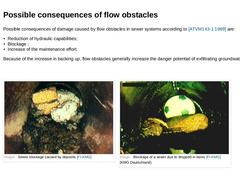
|

Possible consequences of damage caused by flow obstacles in sewer systems according to [ATVM143-1:1989] are: - Reduction of hydraulic capabilities;
- Blockage ;
- Increase of the maintenance effort.
Because of the increase in backing up, flow obstacles generally increase the danger potential of exfiltrating groundwater. |
(Image: Sewer blockage caused by deposits [FI-KMG])
|
(Image: Blockage of a sewer due to dropped in items [FI-KMG](KMG Deutschland))
|
|
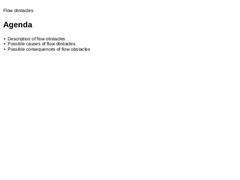
|

|
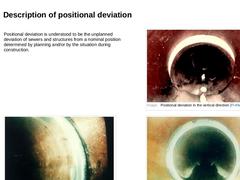
|

|
Positional deviation is understood to be the unplanned deviation of sewers and structures from a nominal position determined by planning and/or by the situation during construction. | (Image: Positional deviation in the vertical direction [FI-KMG])
| | (Image: Positional deviation in the horizontal direction [FI-IfK])
| (Image: Positional deviation in the longitudinal direction [FI-IfK])
|
|
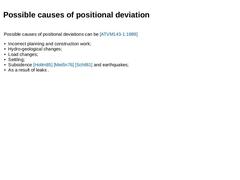
|

|
Possible causes of positional deviations can be [ATVM143-1:1989] - Incorrect planning and construction work;
- Hydro-geological changes;
- Load changes;
- Settling;
- Subsidence [Hollm85] [Meißn76] [Schil81] and earthquakes;
- As a result of leaks .
|
|
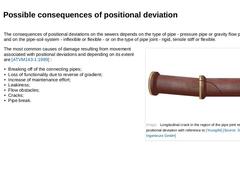
|

|
The consequences of positional deviations on the sewers depends on the type of pipe - pressure pipe or gravity flow pipe - and on the pipe-soil-system - inflexible or flexible - or on the type of pipe joint - rigid, tensile stiff or flexible. (Image: Longitudinal crack in the region of the pipe joint resulting positional deviation with reference to [Young84] [Image: S&P GmbH])
The most common causes of damage resulting from movement associated with … |
|

|

|
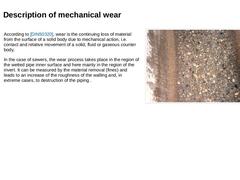
|

| (Image: Tilting channel experiment to DIN 19565 - Surface of a concrete pipe after 100000 changes of load)
According to [DIN50320], wear is the continuing loss of material from the surface of a solid body due to mechanical action, i.e. contact and relative movement of a solid, fluid or gaseous counter body. In the case of sewers, the wear process takes place in the region of the wetted pipe inner surface and here mainly in the region of the invert. … |
|
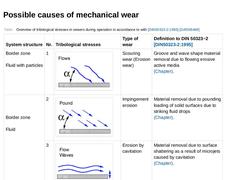
|

(Table: Overview of tribological stresses in sewers during operation in accordance to with [DIN50323-2] [DAfStB468]) |
|
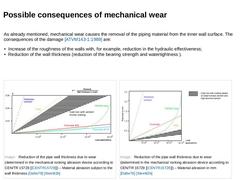
|

|
As already mentioned, mechanical wear causes the removal of the piping material from the inner wall surface. The consequences of the damage [ATVM143-1:1989] are: - Increase of the roughness of the walls with, for example, reduction in the hydraulic effectiveness;
- Reduction of the wall thickness (reduction of the bearing strength and watertightness ).
|
(Image: Reduction of the pipe wall thickness due to wear (determined in the mechanical rocking abrasion … |
|
|
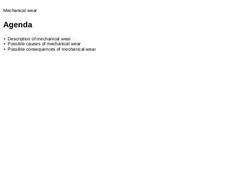
|

|
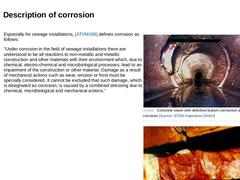
|

|
(Image: Conctrete sewer with defective branch connection and corrosion)
|
|
(Image: Corrosion of bricks [Frank92])
|
Especially for sewage installations, [ATVM168] defines corrosion as follows: "Under corrosion in the field of sewage installations there are understood to be all reactions to non-metallic and metallic construction and other materials with their environment which, due to chemical, electro-chemical and microbiological processes, lead to … |
|
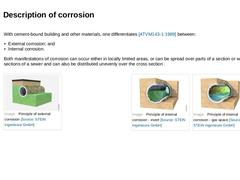
|

|
With cement-bound building and other materials, one differentiates [ATVM143-1:1989] between: - External corrosion; and
- Internal corrosion.
Both manifestations of corrosion can occur either in locally limited areas, or can be spread over parts of a section or whole sections of a sewer and can also be distributed unevenly over the cross section . | | (Image: Principle of external corrosion)
| |
(Image: Principle of internal corrosion - invert)
|
(Image: Principle … |
|
|
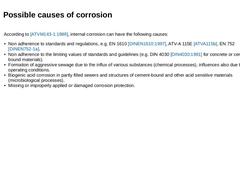
|

|
According to [ATVM143-1:1989], internal corrosion can have the following causes: - Non adherence to standards and regulations, e.g. EN 1610 [DINEN1610:1997], ATV-A 115E [ATVA115b], EN 752 [DINEN752-1a].
- Non adherence to the limiting values of standards and guidelines (e.g. DIN 4030 [DIN4030:1991] for concrete or cement-bound materials).
- Formation of aggressive sewage due to the influx of various substances (chemical processes), influences also due …
|
|
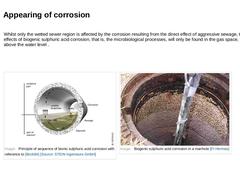
|

|
Whilst only the wetted sewer region is affected by the corrosion resulting from the direct effect of aggressive sewage, the effects of biogenic sulphuric acid corrosion, that is, the microbiological processes, will only be found in the gas space, i.e. above the water level . |
(Image: Principle of sequence of bionic sulphuric acid corrosion with reference to [Bock84] [Image: S&P GmbH])
|
(Image: Biogenic sulphuric acid corrosion in a manhole [FI-Hermea])
|
|
|
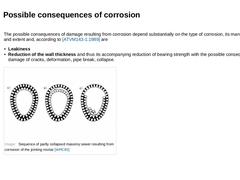
|

|
The possible consequences of damage resulting from corrosion depend substantially on the type of corrosion, its manifestation and extent and, according to [ATVM143-1:1989] are - Leakiness
- Reduction of the wall thickness and thus its accompanying reduction of bearing strength with the possible consequential damage of cracks, deformation, pipe break, collapse.
(Image: Sequence of partly collapsed masonry sewer resulting from corrosion of the jointing … |
|
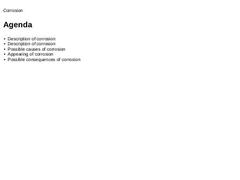
|

|
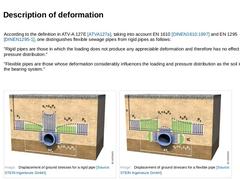
|

|
According to the definition in ATV-A 127E [ATVA127a], taking into account EN 1610 [DINEN1610:1997] and EN 1295 [DINEN1295-1], one distinguishes flexible sewage pipes from rigid pipes as follows: "Rigid pipes are those in which the loading does not produce any appreciable deformation and therefore has no effect on pressure distribution." "Flexible pipes are those whose deformation considerably influences the loading and pressure distribution as the … |
|
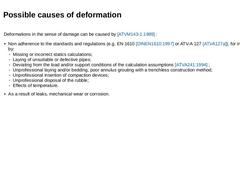
|

|
Deformations in the sense of damage can be caused by [ATVM143-1:1989] : - Non adherence to the standards and regulations (e.g. EN 1610 [DINEN1610:1997] or ATV-A 127 [ATVA127a]), for instance by:
- Missing or incorrect statics calculations;
- Laying of unsuitable or defective pipes;
- Deviating from the load and/or support conditions of the calculation assumptions [ATVA241:1994] ;
- Unprofessional laying and/or bedding, poor annulus grouting with a trenchless …
|
|